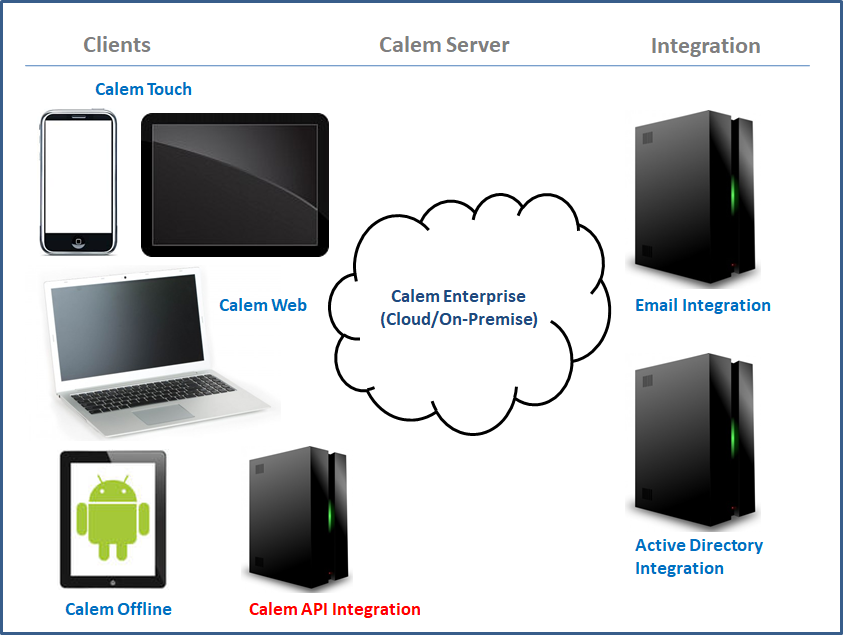Calem Blogs
Calem Integration 2: REST API
Calem Enterprise comes with integration capabilities including:
- Email Integration: service request submission, service request and work order interaction via emails.
- Application Programming Interface (API): the APIs to read, update and delete records in Calem. It is ideal for third party applications to integrate with Calem via APIs.
- Custom Triggers: application code in Calem server. The triggers are fired when a database records are inserted, updated or deleted.
1. Overview
APIs are discussed in this blog. Calem Enterprise comes with REST APIs. Other applications can use the REST API to fetch data from Calem; or update data in Calem. For instance, a customer likes to create a service request in Calem when a device is not reachable from a network monitoring system.
2. Sandbox vs. Production
The REST API should be developed and tested in a Sandbox environment before deploying to the Production environment. This is good practice and should be adhered to.
3. Rest APIs
The REST APIs are a powerful set of programming interfaces for third party applications. They can be used to insert, update, read and delete objects in Calem Enterprise. See Calem Enterprise REST API manual for more information.
- Relative URLs are listed below. For instance, /api/get/cm_asset/009621a0-56c2-b974-f162-640541bd748a.
- Full path for Production: https://acme.calemeam.com/api/get/cm_asset/009621a0-56c2-b974-f162-640541bd748a (Replace "acme" with your service name).
- Full path for Sandbox: https://acmetest.calemeam.com/api/get/cm_asset/009621a0-56c2-b974-f162-640541bd748a (Replace "acme" with your service name).
| API Type | API Sample |
| Get an object by Id | Get asset with id "009621a0-56c2-b974-f162-640541bd748a":
GET /api/get/cm_asset/009621a0-56c2-b974-f162-640541bd748a |
| Get objects by query | Get assets with query: asset_no like 'pump%' and last_modified>='2014-12-11' (URL encoded in query below). GET /api/search/cm_asset/w= asset_no%20like%20%27pump%25%27%20and%20last_modified%3E%3D%272014-12-11%27 |
| Insert an object | Insert an asset with the following info: note=My asset note; location_id=My location id; in_id=My asset type id POST /api/insert/cm_asset note=My%20asset%20note&location_id=My%20location%20id&in_id=My%20asset%20type%20id |
| Update an object | Update an asset with the following info: note=My asset note; in_id=My asset type id note=My%20asset%20note&in_id=My%20asset%20type%20id |
| Delete an object | Delete an asset with Id: DELETE /api/delete/cm_asset/009621a0-56c2-b974-f162-640541bd748a |
| API Key Attributes | Get the attributes for an API key including the max number of rows to fetch per each API search invocation. GET /api/get/cm_vt_apikey_so/attributes |
| Database Status | Get the database status to monitor database of Calem. GET /api/get/cm_vt_db_so/status |
| NFS Status | Get the NFS status to monitor Calem cluster status when applicable. GET /api/get/cm_vt_nfs_so/status |
4. Identify Objects from Forms
Forms are based on objects (also called models). You can find the object used by a form - see Step 0 of this blog for more info. Field names are also shown in forms. You can find more info about a field in Data Dictionary.
5. Integration APIs
There are integration APIs that are developed for custom projects when the standard APIs above are not sufficient. Contact us when needs arise for your integration projects.
Additional resources
- Calem Integration Part IV: How to Subscribe to Data Changes in Calem
- Calem Enterprise REST API Guide (customer account required)
- How to Add Custom Fields and Customize Forms
- How to Use Data Dictionary in Calem
- User Guide and Admin Guide (customer account required)
- Calem Enterprise Training Site
- Calem Enterprise Blogs
- Calem Enterprise demo
By accepting you will be accessing a service provided by a third-party external to https://eam.calemeam.com/

